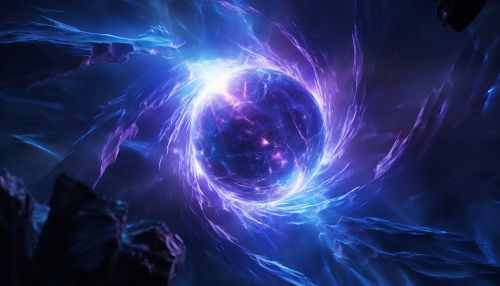The Physics of Neutron Stars and Pulsars
Introduction
Neutron stars are celestial objects that are formed as a result of the gravitational collapse of a massive star after a supernova explosion. These stars are incredibly dense, with a mass approximately 1.4 times that of the sun, but with a radius of only about 10 kilometers. This results in a density that is a billion times greater than that of steel.
Pulsars, on the other hand, are a type of neutron star that emit beams of radiation from their magnetic poles. These beams can be detected from Earth as a series of regular pulses, hence the name 'pulsar'.


Formation of Neutron Stars
The formation of a neutron star begins with a star that has a mass between about 8 and 30 solar masses. When such a star exhausts its nuclear fuel, it undergoes a catastrophic collapse under its own gravity, leading to a supernova explosion. The core of the star is compressed during this process, leading to the formation of a neutron star.
The core collapse triggers a shock wave that propagates outward, blowing off the outer layers of the star in a spectacular explosion. The remnant core is left behind, which is now a neutron star.
Properties of Neutron Stars
Neutron stars are characterized by their extreme density, strong gravitational fields, and rapid rotation. They also have intense magnetic fields, up to a trillion times stronger than Earth's magnetic field. These properties result in a number of unique and interesting phenomena.
Density and Mass
Neutron stars are incredibly dense. A sugar-cube-sized amount of neutron-star material would weigh about as much as a mountain on Earth. This is because the protons and electrons in the star's atoms are squeezed together by the immense gravitational pressure, creating neutrons.
Gravitational Field
The gravitational field of a neutron star is about 2 x 10^11 times stronger than the Earth's gravitational field. This means that an object on the surface of a neutron star would weigh about 200 billion times more than it would on Earth.
Rotation
Neutron stars rotate extremely rapidly, with periods ranging from milliseconds to seconds. The rapid rotation is a result of the conservation of angular momentum during the star's collapse.
Magnetic Field
Neutron stars have incredibly strong magnetic fields, up to a trillion times stronger than Earth's magnetic field. These magnetic fields are responsible for the emission of radiation from the star's magnetic poles, which can be detected on Earth as a pulsar.
Pulsars
Pulsars are a type of neutron star that emit beams of radiation from their magnetic poles. The radiation is emitted as a series of regular pulses, which can be detected from Earth. The time between pulses is extremely regular, often comparable to the precision of an atomic clock.
Discovery of Pulsars
The first pulsar was discovered in 1967 by Jocelyn Bell Burnell and Antony Hewish. The regularity of the pulses initially led them to consider the possibility that they were detecting signals from an extraterrestrial civilization, but they soon realized that they were observing a new type of celestial object.
Pulsar Emission Mechanism
The emission mechanism of pulsars is not fully understood, but it is believed to be related to the star's intense magnetic field. The magnetic field accelerates charged particles to near the speed of light, causing them to emit radiation.
Neutron Stars and Pulsars in Astrophysics
Neutron stars and pulsars are of great interest in astrophysics. They provide a unique laboratory for studying the behavior of matter under extreme conditions, and they are also useful tools for testing theories of gravity.
Neutron Stars and Nuclear Physics
Neutron stars provide a unique laboratory for studying nuclear physics. The extreme density of neutron stars means that the neutrons are in a state of matter known as neutron degenerate matter, which is not found anywhere else in the universe.
Pulsars and Tests of Gravity
Pulsars are also useful tools for testing theories of gravity. The precise timing of pulsar pulses allows for very accurate measurements of the pulsar's motion. These measurements can be used to test predictions of theories of gravity, such as General Relativity.
